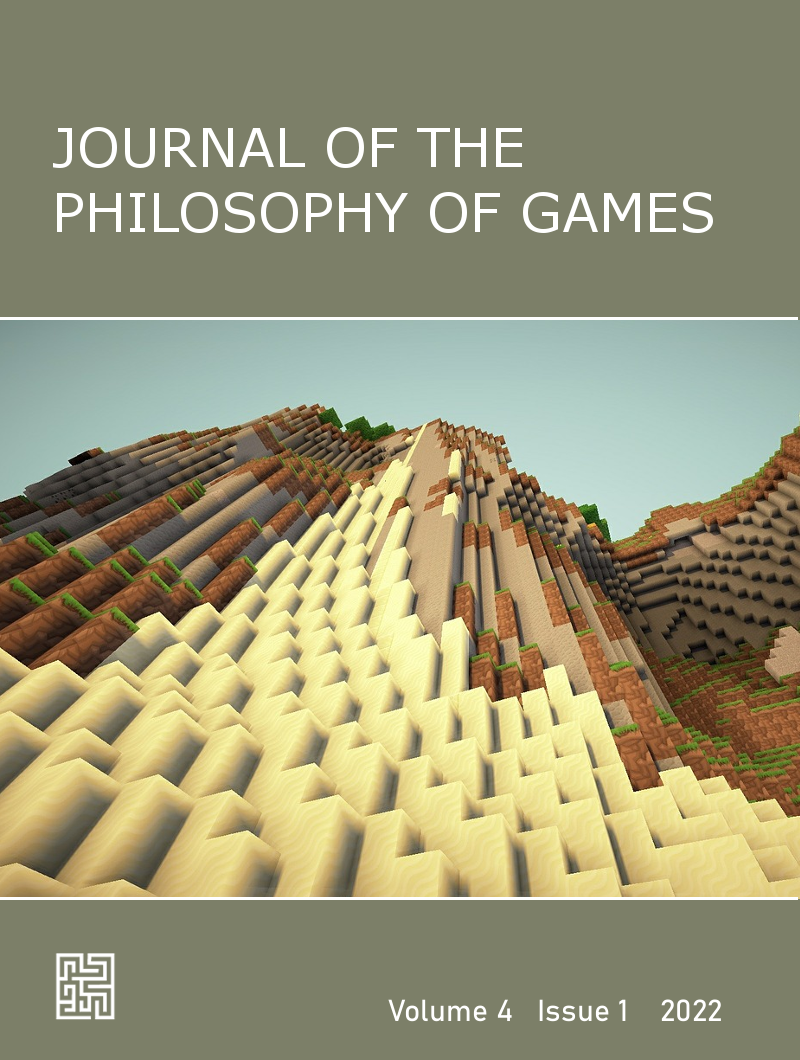Video Game Fictions: A Dual-Work View
DOI:
https://doi.org/10.5617/jpg.9230Abstract
Video games fictions are interactive: some of the content is set by the game designer and some is set by the player. However, philosophers disagree over how this interaction is reflected within the fictional content of video games. First, I will show that games and playthroughs are two distinct works of fiction with their associated fictional content. Second, I argue that players engage with both fictional works when playing a video game. They imagine the fictional truths associated with the game and those associated with their playthrough. Thus, I defend what I will call a Dual-Work View of our engagement with video game fictions. To do so, I show that games have accessible fictional content, that games are distinctively incomplete fictions, and that players engage with this distinctive incompleteness. My goal is to offer a clear account of the fictional content of video games.
References
Games
Naughty Dog (20130). The Last of Us.
BioWare (2013). Mass Effect 3.
Rockstar Games (2001). Grand Theft Auto III.
Valve Corporation (2011). Portal 2.
Square Enix (1997). Final Fantasy VII.
References
Aarseth, E. J. (1997). Cybertext: Perspectives on Ergodic Literature. JHU Press.
Hogenbirk, Hugo Dirk, Marries van de Hoef, and John-Jules Charles Meyer. 2018. “Clarifying Incoherence in Games.” Journal of the Philosophy of Games 1 (1). https://doi.org/10.5617/jpg.2653.
Juul, J. (2005). Half-Real: Video Games between Real Rules and Fictional Worlds. MIT Press.
Meskin, Aaron, and Jon Robson. 2012. “Fiction and Fictional Worlds in Videogames.” In The Phi-losophy of Computer Games, edited by John Richard Sageng, Hallvard Fossheim, and Tarjei Mandt Larsen, 7:201–17. Philosophy of Engineering and Technology. Dordrecht: Springer Netherlands. https://doi.org/10.1007/978-94-007-4249-9_14.
Nguyen, C. Thi. 2019. “Games and the Art of Agency.” The Philosophical Review 128 (4): 423–62. https://doi.org/10.1215/00318108-7697863.
Ricksand, Martin. 2020. “Walton, Truth in Fiction, and Video Games: A Rejoinder to Willis.” The Journal of Aesthetics and Art Criticism 78 (1): 101–5. https://doi.org/10.1111/jaac.12707.
Suduiko, Aaron Graham. 2018. “The Role of the Player in Video-Game Fictions.” Journal of the Philosophy of Games 1 (1). https://doi.org/10.5617/jpg.4799.
Tavinor, Grant. 2005. “Videogames and Interactive Fiction.” Philosophy and Literature 29 (1): 24–40. https://doi.org/10.1353/phl.2005.0015.
———. 2009. The Art of Videogames. New Directions in Aesthetics 10. Malden, MA: Wiley-Blackwell.
Walton, Kendall L. 1990. Mimesis as Make-Believe: On the Foundations of the Representational Arts. Cambridge, Mass.: Harvard University Press.
Wildman, Nathan, and Richard Woodward. 2018. “Interactivity, Fictionality, and Incompleteness.” In The Aesthetics of Videogames, edited by Grant Tavinor and Jon Robson. Routledge.
Willis, Marissa. 2020. “The Importance of the Playthrough: A Response to Ricksand.” The Journal of Aesthetics and Art Criticism 78 (1): 105–8. https://doi.org/10.1111/jaac.12691.
Willis, Marissa D. 2019. “Choose Your Own Adventure: Examining the Fictional Content of Video Games as Interactive Fictions.” The Journal of Aesthetics and Art Criticism 77 (1): 43–53. https://doi.org/10.1111/jaac.12605.
Downloads
Published
Issue
Section
License
Authors who publish with this journal agree to the following terms:
- Authors retain copyright in their articles and grant the Journal of the Philosophy of Games (JPG) right of first publication with the work simultaneously licensed under the following licence: Creative Commons Licence : CC BY-NC-ND 4.0. The licence allows others to share the work for non-commercial purposes with an acknowledgement of the work’s authorship and initial publication in this journal, but does not allow others to create derivative works based on the work without the author’s permission.
- Authors are allowed to enter into separate, additional contractual arrangements for the non-exclusive distribution of the journal’s published version of the work (e.g., post it to an institutional repository or publish it in a book), provided that such distribution includes an acknowledgement of the article’s initial publication in JPG.
- Authors are permitted and encouraged to post their work online (e.g., in institutional repositories or on their website) prior to and during the submission process, as it can lead to productive exchanges, as well as earlier and greater citation of published work (See The Effect of Open Access). Authors who distribute their work after its acceptance by JPG but prior to its publication agree to indicate on the manuscript that it will be published in JPG. Authors agree that they will not publish their work in any other journals, anthologies, or monographs before the date on which their work is published by JPG.
- Authors grant JPG a royalty-free, non-exclusive, perpetual, worldwide license to create derivative works based on their articles and to publish their articles or any part of their articles in compilations and anthologies.
In special cases, it may be possible for the author to negotiate an open licence other than the CC BY-NC-ND.



